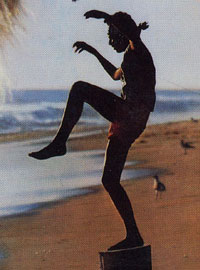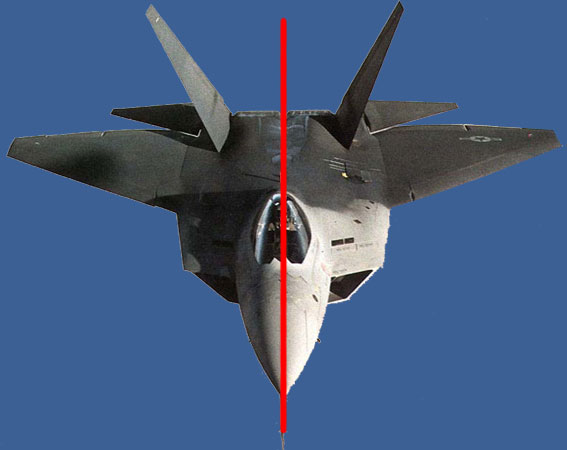 Most old school Coaches would talk about the importance of the "Balance Point" like Mr Miyagi in the Karate Kid. New school thought would say that this may produce an accurate pitcher but it will destroy velocity in return. New school thought would then talk about how balance is effective only if established within the movement of the pitcher. This is what I call, "Pitching and the Point of Balance" not the "Balance Point."
Most old school Coaches would talk about the importance of the "Balance Point" like Mr Miyagi in the Karate Kid. New school thought would say that this may produce an accurate pitcher but it will destroy velocity in return. New school thought would then talk about how balance is effective only if established within the movement of the pitcher. This is what I call, "Pitching and the Point of Balance" not the "Balance Point."
In my article Olympic Lifting Increases Pitching Velocity, I use Newton's second law to prove why Olympic Lifting will increase your velocity. If you have not read this article, please do. It is important to first understand how velocity is generated before trying to understand how to develop more efficient velocity.
I will now illustrate how balance through aerodynamics can help us as pitchers to reach our top velocity but first lets look at the definition of aerodynamics.
The Science Behind the Balance Point
The definition of Aerodynamics is the study of the forces of air, acting on objects in motion, relative to air.
 Think of velocity as a jet, like the picture here. The red line illustrates the balance point of the aerodynamics of the machine. Notice how the jet has the same amount of mass on the left side of the line as the right. The mass is also symmetrical which is what allows it to stay in flight because the aerodynamics of the right side of the jet is the same as the aerodynamics of the left. Also see the line as the quickest distance between two points. If the jet stays on that straight line, it will get to its final destination faster than if it strayed off the line, on its way to the end.
Think of velocity as a jet, like the picture here. The red line illustrates the balance point of the aerodynamics of the machine. Notice how the jet has the same amount of mass on the left side of the line as the right. The mass is also symmetrical which is what allows it to stay in flight because the aerodynamics of the right side of the jet is the same as the aerodynamics of the left. Also see the line as the quickest distance between two points. If the jet stays on that straight line, it will get to its final destination faster than if it strayed off the line, on its way to the end.
To reduce the velocity of the jet without decreasing the force applied by its engines, we can use the laws of aerodynamics to create inefficiencies. We could do this by throwing off it's balance point or symmetry by adding more mass to the left side of the jet. This would add drag on the left side of the jet, which would decrease velocity to the jet in two ways: the first way is by decreasing the force applied by the engines because of the added drag or pull on the engines, and the second way is by forcing the jet to travel outside of the straight line in a more curved direction constantly forcing the jet to re-correct its path.
"I am sure you are wondering how this applies to pitching, but this is the quantum leap you must make here."
I will use these pictures of Felix Hernandez to help you with this leap. Felix has one of the hardest fastballs in the game and you will now see one reason why.
I have added the red line to show you the same information as with the fighter jet. Notice how the weight distribution of his mass on both sides of the red line is almost symmetrical in all three pictures. This is what keeps Felix's body moving forward on his "Point of Balance." If his mass was more on the right side than the left, he would loss considerable velocity just like with the aerodynamics of the fighter jet. This is because his arm would create drag on his body and he would then need to over compensate by pulling his arm across his body, to keep his body moving forward. This would force him, like the jet, to stray off the straight line path and the drag would decrease the force that he created in his lower half when driving off the mound.
This doesn't mean you must throw over the top. What it means is you must keep your weight evenly distributed over your "Point of Balance." So, if you throw sidearm, you need to distribute your weight more over the outside part of your landing foot, using your hips to shift the weight and not your shoulders.
The key here is what you see Felix and all the hard throwers doing. This is using their hips to control their "center of gravity" while balancing all of their weight over their landing leg just like how the jet does the same thing with its wing span and nose of the plane. This is the reason why pitcher's must have very strong legs and core strength, so they can stabilize their legs and core to control this "Point of Balance." This stablization around their "Point of Balance" will reduce inefficiencies which will promote higher velocity.
The best way to find your "Point of Balance" is with a photograph. Draw a line from your belt buckle to your landing leg toes. With this line you should see your weight evenly distributed on both sides of the line. If not then you must make your adjustments with your hips and front leg.


I dont think this works for K-Rod and he throws as hard or harder than felix.
http://images.wikia.com/openserving/sports/images…
I am glad you brought this point up. Just because someone is a Major League Pitcher and throws hard doesn't mean they have perfect mechanics. This is why Major League Pitchers have arm surgery. In the case of K Rod his weight is off to the left when he pitches. You notice this when he flies off the mound to the left after his delivery. This means he is misdirecting some of his momentum. This is better than if he landed open to the right. This would prevent his hips from closing off. The main goal and purpose of this article is that good "Balance" equates to good velocity.